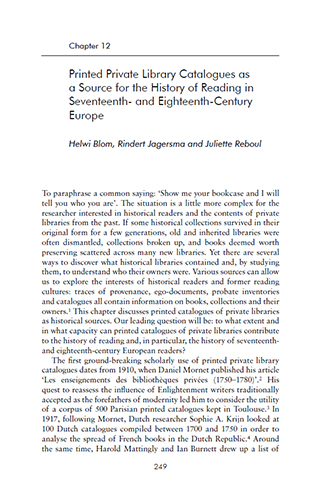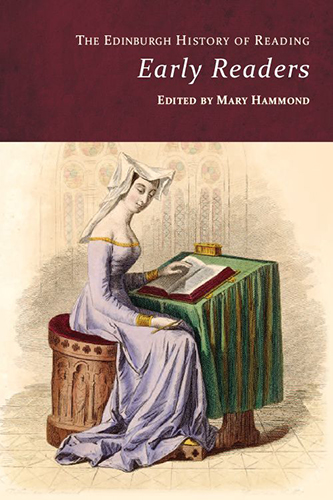

Helwi Blom, Rindert Jagersma, and Juliette Reboul
Printed Private Library Catalogues as a Source for the History of Reading in Seventeenth- and Eighteenth-Century Europe
In: Mary Hammond (ed.), Edinburgh History of Reading. Early Readers (Edinburgh: Edinburgh University Press, 2020), pp. 249–269.
Part one of four volumes on the history of reading, edited by Mary Hammond and Jonathan Rose.
ISBN: 9781474494854 (Paperback) | 9781474446082 (Hardback) | 9781474446105 (Ebook, ePub) | 9781474446099 (Ebook, PDF)
WorldCat
Website: https://edinburghuniversitypress.com/book-the-edinburgh-history-of-reading.html
Abstract:
“This chapter discusses printed catalogues of private libraries as historical sources. Our leading question will be: to what extent and in what capacity can printed catalogues of private libraries contribute to the history of reading and, in particular, the history of seventeenth- and eighteenth-century European readers?”
(p. 249)
“In Chapter 12, Helwi Blom, Rindert Jagersma and Juliette Reboul step into the hotly contested terrain of book ownership as evidence of reading practices using purpose-built digital tools that are able to map the details of book ownership across space and time in Europe in the seventeenth and eighteenth centuries. They argue that an exhaustive quantitative analysis of the movement of texts is instrumental in indicating markets for them driven by real readers, not merely because they are able to indicate social and professional patterns, but because, crucially, ‘each discrepancy and deviation might indicate a personal reading interest’.”
(Mary Hammond, Introduction, pp. 8-9)
This article is available
Direct download to scan: PDF (0,2 MB)
Abstract of volume:
“[Early Readers] Reveals the experience of reading in many cultures and across the ages
– Covers reading practices from China in the 6th century BCE to Britain in the 18th century
– Employs a range of methodologies from close textual analysis to quantitative data on book ownership
– Examines a wide range of texts and ways of reading them from English poetry and funeral elegies to translated books in Peru
– Challenges period-based models of readership history
Early Readers presents a number of innovative ways through which we might capture or infer traces of readers in cultures where most evidence has been lost. It begins by investigating what a close analysis of extant texts from 6th-century BCE China can tell us about contemporary reading practices, explores the reading of medieval European women and their male medical practitioner counterparts, traces readers across New Spain, Peru, the Ottoman Empire and the Iberian world between 1500 and 1800, and ends with an analysis of the surprisingly enduring practice of reading aloud.”
The article is a product of the MEDIATE project.
Illustration:
Portret van een man, François André Vincent, ca. 1795. Rijksmuseum, SK-A-3931